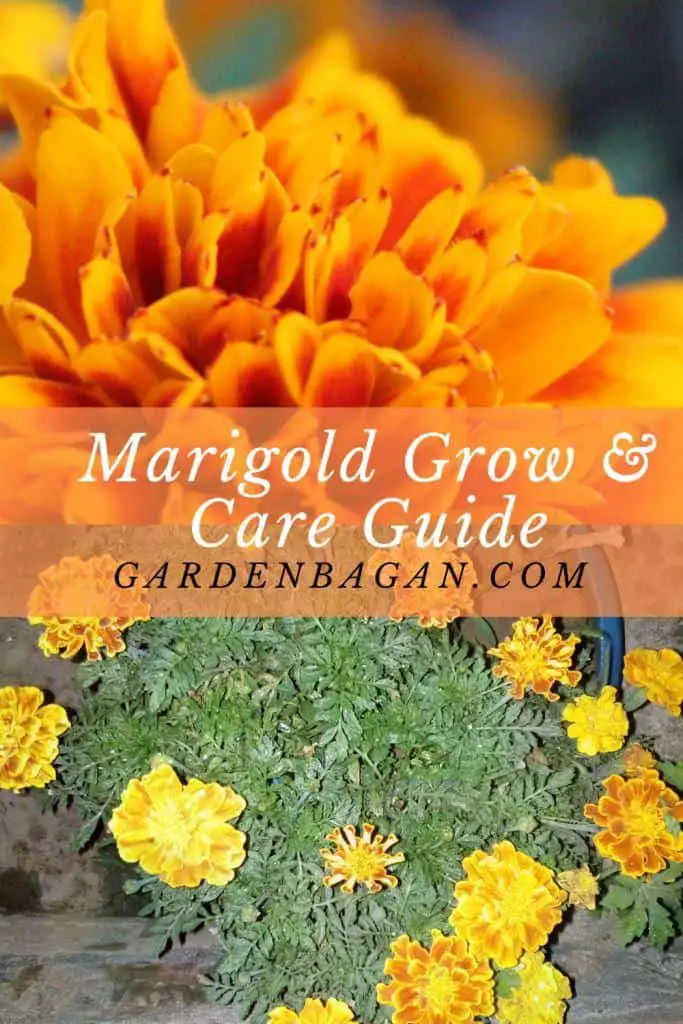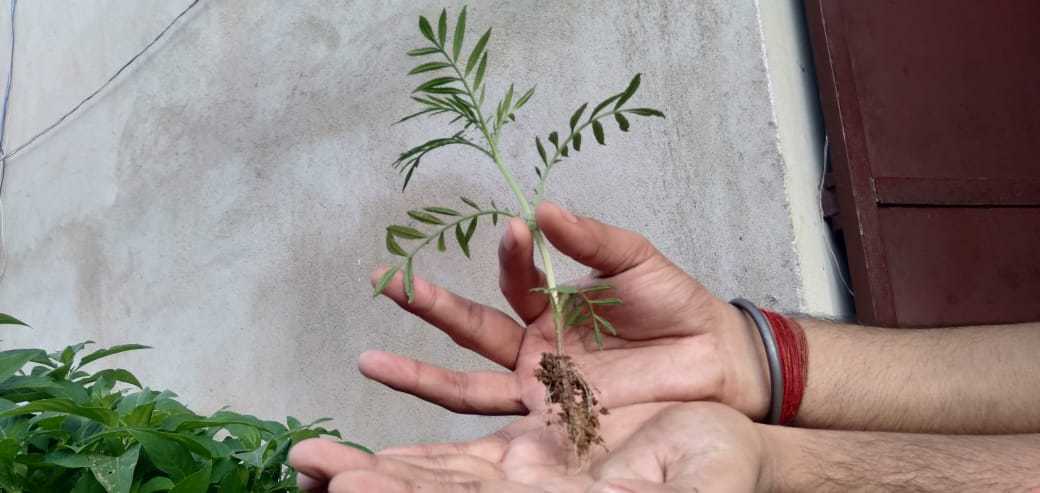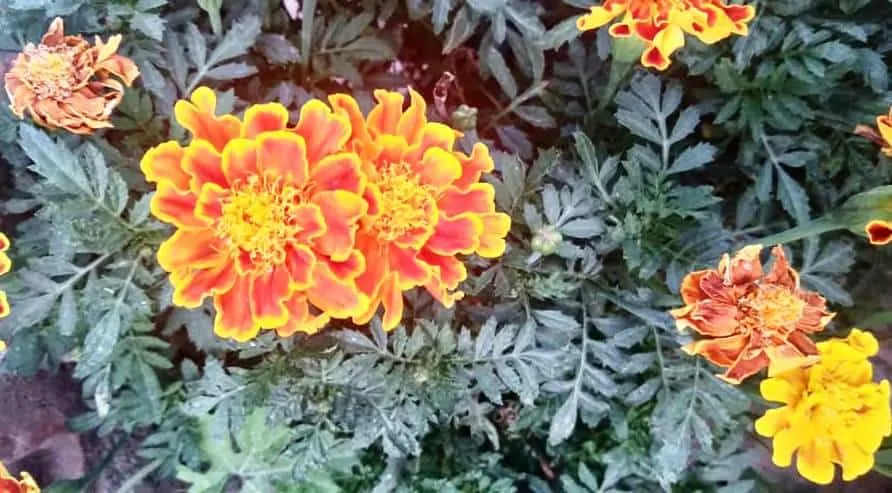Marigolds (botanical name Tagetes) are mainly annual, herbaceous plants of the Asteraceae family and native of central and south America. It is easy to grow and mostly attracted by its floral beauty and wide adaptation with minimal maintenance.
Marigolds are widely cultivated with many cultivars for the use of cut-flower trade, as ornamental plants, and for medicinal purposes. Availability of flower year-round and 45 to 50 days need for blooming. When do marigolds bloom-Time and Temperature?

Types of marigolds
There are 50 species of marigolds but 4 most common species are grown commercially: African or American marigolds (Tagetes erecta), French marigolds (T. patula), sweet-scented marigolds (T. lucida) and signet marigolds (T. enuifolia).
African marigold (Tagetes erecta):
The African marigold is also known as American Marigold, Mexican Marigold, and Giant Marigold. This plant is an aromatic, hardy, annual and grows about 90-100 cm tall, stem erect and branched.
It grows well in sandy, loamy and heavy clay with slightly acidic soil and in a fully sunny place.
Stems are going to under pressure due to the heavy flower heads, in that case, staking or other support may be needed for this variety.
April is the perfect time of sowing seed. And the flower comes in late spring after seed sowing. Flower color varies from lemon, yellow, golden yellow or orange.
They have larger flowers but a shorter flowering period.
French Marigold (Tagetes patula):
These marigolds are small bushy, compact and 15- 30 cm in height. It can grow in both sandy and clay soil with a good drainage system.
Transplanting the plants during the months April to May to the main field. The flowering time is from May to September.
The smaller size flower comes in many colors varies from yellow to mahogany red and often multiple colors in one flower head.
Sweet-scented marigolds (T. lucida) :
This marigold mainly perennial in nature and grows 46-76 cm tall, medium and bushy plant, native to Mexico. Flower color is yellow and available round the year.
Leaves having aroma just like aniseed, it is used as a culinary herb also used as a substitute for tarragon.
Due to this scent, its common name is Sweet-scented marigolds.
Dried flowers, leaves and whole plants used for medicinal purposes as a powder form. It has a strong medicinal value than other species.
It is used for the treatment of human disease internally in case of diarrhea, nausea, indigestion, colic, malaria and feverish illnesses.
Signet marigolds (T. enuifolia):
This annual plant gives season-long blooms from early summer until frost. Perform best under full sun, average moist and well-drained soil with a 15-30 cm tall plant.
The lemon yellow or warm orange color fragrant flower comes in 8-10 weeks.
These colored blossoms plants are used as bedding and edging for the creation of additional beauty in landscaping.
Bees, butterflies, and birds are attracted by the plant.
where to grow Marigold
Site selection:
Most of the marigolds prefer to grow in a place of full sunlight and partial shade. It should be protected from strong winds.
If you place it under the full shade, It will increase the vegetative growth of the plant and doesn’t generate any flower.
If the area is moist and cool, then the plant will be attacked by the powdery mildew disease and won’t bloom well.
Temperature:
During the growing period, marigolds need a temperature between 14.5°C – 28.6°C.
Proper temperature influences the improvement of the flowering. For the production of quality flower, it needs 5 to 6 hours of sunlight in winter.
Flower production is adversely affected by the temperature below 26.2°C – 36.4°C
which leads to reduce flower size and number. All species of Marigold are damaged by the heavy frost.
Soil:
Marigolds can grow in different types of soil. It grows well in fertile sandy loam, moist, well-drained, friable soil and having a good water holding capacity.
Soil pH range 6.5 to 7 is preferred by the Marigolds.
Plantation of marigolds
Field preparation:
Seedbed is prepared by plowing and mix with well rotten Farm Yard Manure (FYM) before sowing seed.
Before sowing or planting dig the soil about 6 inches to loosen it and remove the weeds, plastics, and stones.
It should be confirmed that soil is friable with low moisture. Low moisture is necessary for the successful growth of Marigold.
Propagation of marigolds:
There are two systems of planting methods. One is direct seed sowing and another is cutting.
Seed sowing is preferred than cutting. Marigolds that come from seed would be taller, vigorous and high yielder.
You can also grow marigold from cuttings, follow my previous article for a complete guide.
Sowing of seed:
April to June is the best time for sowing seed in the seedbed. It should be just below the soil surface. Try to maintain the depth of the soil about ¼ inch.
Seeds should be treated before sowing. Every sowing seedbeds should be watered frequently.
About 2- 3 kg of Marigold seed is required per hectare area. Check out these high-quality hybrid marigold seeds.
Transplanting of Marigold seedlings:
After sowing seeds, a new plant will appear within a few days.
About 30 days older seedlings with two leaves are suitable for transplanting to an individual container or to the fields in the evening hours.
Before transplanting the field should be prepared followed by the 2 to 3 plowing.
Due to the fast-growing root system of marigolds, a plant can be easily established in the main field after transplanting.
If you are planting marigolds in Containers then first grow it in 4-inch pots. After ten days transfer these seedlings to bigger pots. 8-10 inch pot is ideal for growing Marigold.
Spacing:
Following these plants to plant and row to row distance is recommended for marigold. It is best for commercial standards.
- 40 cm x 40 cm for African marigold and
- 30 cm x 30 cm for French marigold
For better development of plants and getting higher flower yield, proper spacing should be maintained.

Care of marigolds
Watering:
A little amount of water is needed for marigold plantation.
It likes friable soil with low moisture. After transplanting a very minimum amount of water should be applied to each plant on a 2 or 3 days interval.
Do not apply Water from the overhead of the plants especially during the growing period. It should be applied at the base of the plant.
Excess water should be drained out. Marigolds survive in drought conditions for some time. In dry and hot weather do water regularly to keep the low moisture.
Manures and fertilizer:
If the soil is rich with high organic material, then no need to add additional fertilizer.
If the nutrient condition of the soil is very poor then high doses of nitrogen, a moderate level of phosphorus and potash should be applied to the soil. It is necessary for getting healthy soil and better development of plant root and quality flowers.
During land preparation, 40 to 50 Kg FYM (Farm Yard Manure) should be applied to the soil.
100 kg/h of nitrogen and 80 kg/h of each phosphorus and potash should be applied in the soil as a basal dose.
And rest of the nitrogen is applied two or three times during the vegetative growth at fifteen days Interval.
Irrigation is needed after the application of fertilizer.
Fertilizer enhances the vegetative growth of the plant and encourages quality blooming. Due to the presence of potash fertilizer, it helps the plant to prolong the flowering period.
In case of indoor gardening in a container or in a pot, mix the soil with fertilizer about 1 teaspoon per plant before transplanting. You can also dilute it with water and apply periodically to the plants.
You should be careful don’t add an excess of fertilizers which may result in vigorous growth of foliage instead of flowers.
Mulching:
In a marigold field or in a container mulching is important.
It helps to conserve the soil moisture, prevent weeds, help the seedlings for establishing and improve the aesthetic look of the garden.
Pinching:
Pinching the marigolds plant when the age of the plant is about 30 to 45 days. As a result, plants come into bushier growth and gives a uniform size of good quality and a large number of flowers.
when the flowering going to be slow then pinch (cut) its stem back to the nearest leaves. It encourages the plant to produce a new flower.
For complete detail follow my post on How to deadhead marigolds?
Weeding:
Control of weeds in the marigold garden is an important practice. 3 to 4 manual weeding is the best for entire cultivation.
Pest and diseases in Marigold:
Marigolds are often attacked by the following disease and pest:
Don’t worry, with little care and proper knowledge you can easily control these.
| Disease symptom | Control |
| Powdery mildew: whitish powdery growth on the aerial parts of the plant. | Spraying Sulfex (3g/L of water) |
| Leaf spot and Blight: brown necrotic spot grows on the leaves. | Spraying fungicide as per need |
| Bacterial wilt and Stem rot: the main stem of the plants are rotting down. | Soil treated with Mancozeb, Captan, and Metalaxyl |
| Flower bud rot: young bud is affected by the fungus. | Spaying of Mancozeb (2/L of water) |
Marigolds are generally pest-free sometimes these are affected by some garden pests.
Aphid: Spraying neem oil and insecticidal soap on the leaves and plants.
Leaf miners: Keep plants away from excess water and discard the infected parts from the plant.
Thrips: Placing the sticky trap on the surface those are covered by the insect.
- Keeping your garden weed-free and Prevent from the waterlogged condition.
Marigold Flowering:
The marigold plants need about 40 to 45 days to flower after seed sowing.
Blooming period of marigold is long summer until to frost. The flower shape looks like a daisy. Single flower standing alone on a single stem or flower heads tightly packed like clusters.
The range of flower colors varies from golden, yellow, creamy, orange, maroon, mahogany red and so on.
Marigolds Harvesting time:
The maturity time of marigold varies Depending on different types of the cultivar.
About 1.5 to 2.5 months or 45-100 days are required to get a desirable size and perfect color flower from seed to flower.
Ideally, 1.5 months is required for French marigold whereas 2 months is required for African marigold.
It is always good to pick a Fully opened marigold flower. The perfect time for plucking marigold flowers is Early in the morning.
It is recommended, Irrigating the field or container is necessary before plucking the flowers.
It is done so that the flower keeps fresh and fine for a long time after harvest.
After harvesting the fresh flower, You should keep it in a water jar with some preservatives. It helps to increase the shelf life of the flower for further use.
- Getting a better yield of the flower, you should regularly pluck (3 days interval) the flowers and remove the dead flowers.
Marigolds in Indoor
Marigold has well-grown capacity in Outdoor as well as Indoor.
Nowadays, the practice of Indore gardening is increasing profusely. Marigolds can be cultivated in an individual container on a rooftop, in a pot in the balcony, home premises, lawn under the full sunlight and a little bit shade.
Any species of marigold can be grown indoor. For this type of gardening, one can buy 30 days of older marigold seedling for transplanting rather than sowing seed.
It is very easy to grow in a balcony pot, sometimes these pots can be hanged with the wall for getting additional beauty.
Marigolds can grow in most of the soil smoothly.
We can create a small garden in our balcony by placing different types of flowers. Marigolds enhance the beauty of the balcony garden with low maintenance. This garden may use for relaxing places for busy people.
For better growth of the plants, Mix 1 teaspoon of fertilizer (NPK) with soil per pot and water should be applied on the basis of requirement.
This attention is enough for marigolds in indoor gardening.
Following points should be maintained for the indoor garden:
- ✦ Placing the plant where light and air can move easily.
- Prevent Excessive water or waterlogged condition.
- ✦ The pot or container needs an excellent drainage system.
- Loosen the soil of the pot or container at least a day of a week.
- ✦ Spraying the water on the leaves at two weeks’ interval.
The demand of the flower is very high due to its varieties color, shape and size and uses. Commercially it is required for almost the entire year.
The popularity of Marigold’s gardening is increasing among the flower growers due to its short cropping period and with lower investment and minimal care.
Final Words
Hope you have got all your answers. Please let me know if Something lost or just missing here. I would definitely try to include an answer to every query. Write down in the comment box for any help.
Keep reading Keep gardening. Live in Green.


